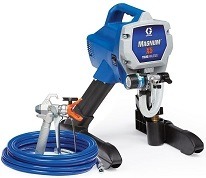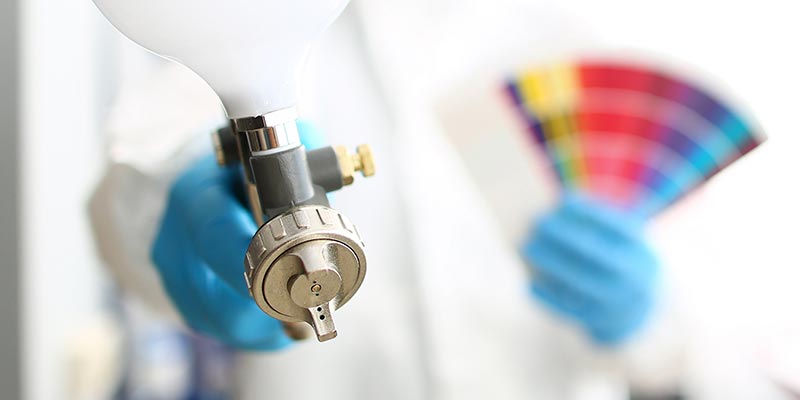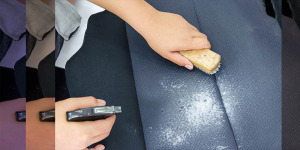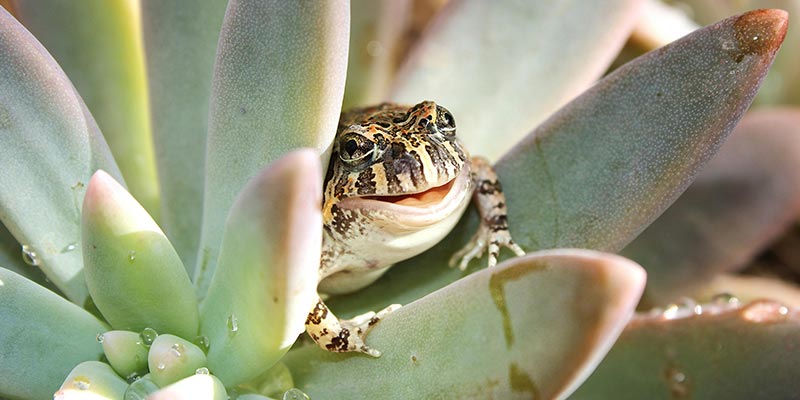Curious about house paint sprayers but no idea where to start? We discuss what to look for when choosing the best paint sprayer for tiny house painting, including features and brands.
Many of us love to play with our tiny home environment. We can express our creativity with color and pattern, and switch the energy of a room simply with a coat of paint and a few decorative flourishes. But an obstacle to our goals is the equipment, and the ‘how to’ of making it happen. While paint rollers and brushes are easy to use, they are slow.
Paint sprayers are a great alternative to rollers and brush. But if you’re going to paint your entire tiny house inside and out, the equipment you choose needs to be more sturdy than a basic handheld sprayer from Home Depot for $50.
While a good paint sprayer costs a bit, they are highly worthwhile due to the time and effort spared when painting. Unlike cheap handheld models, a good quality airless paint sprayer is a long-term investment, a device that can last you for decades or even a lifetime across a variety of different projects and houses. But choosing the right one can be tricky, if you don’t know what you’re looking for.
In this article, we discuss important factors to consider when shopping for paint sprayers for tiny home painting, such as paint sprayer styles, their suitability for tiny home painting, and reputable brands.

Why Use a Paint Sprayer for Tiny Homes?
The best paint sprayer models have several advantages over traditional painting tools such as hand brushes and roller brushes for tiny home owners. The main benefits of using a paint sprayer include speed and efficiency, uniform coating and lower cost. However, you will also need to judge for yourself whether your tiny home space is large enough to warrant investing in a paint sprayer, or whether you are happy to settle on the slower and ‘hand painted’ look of a roller and brush. Some of the benefits to consider are:
Speed and Efficiency
Paint sprayers are fast and efficient. Unlike hand brushes and rollers that require constant dipping into paint, paint sprayers do not need this. You just keep spraying as you move along. That saves time and allows you to cover larger areas in a short time. The spray also covers more surface, unlike brushes and rollers that may not access crevices or divots on the surfaces. Paint sprayers can also paint corners, whereas brushes and rollers cannot do this efficiently. The ability to paint hard-to-reach parts makes paint sprayers a better option than traditional painting equipment.
Uniform Finish
Some projects require perfect finishing and coating. Brushes and rollers often leave brush strokes or texture from the roller head. The precision of paint sprayers ensures there are no such imperfections on your surfaces. The best paint sprayer models give a smooth finish ideal for furniture, doors, window frames and stairs. Ever seen a window frame that has had enamel paint applied with a brush? The brush marks are very obvious and it looks hand-painted, which may be OK for a charming DIY cabin, but not for a contemporary designer tiny house. Paint sprayers give consistency and smooth finish, which is a requirement for professional-quality painting.
Less Paint
Traditional painting tools such as brushes and rollers waste a lot of paint. While you may try to limit the amount of paint dripping as you work, it is inevitable that you will still drip or spill some paint. Or you may apply the paint thicker in some areas (such as corners) than it really needs to be. Further, when you finish painting, there will be a lot of paint leftover inside your brushes and rollers, tins and trays. That is a lot of wasted paint, which increases the cost of your project. Paint sprayers do not waste so much paint, and airless sprayers in particular have very good paint efficiency. They are more precise and hence save you money.
Versatile
Different jobs have different requirements, for instance, compare a large interior wall versus a fine woodworked chair. To get the best outcome for each, you need to do the painting a bit differently for each project, which can be achieved with different sprayer settings such as pattern and flow speed/pressure. However, brushes and rollers do not offer the same level of flexibility or adaptability.
And while you can use different types of paints with a roller and brush… would you use the same set of equipment to apply stain, varnish or even oil your deck? Probably not. But with a paint sprayer, you can. Most paint sprayers can handle a large range of fluids, not just paint.
Paint sprayers are incredibly versatile and adjustable to suit your project needs. Whether you are a homeowner or professional painter, sprayers allow you to efficiently complete your project without hassle.
What is the Best Paint Sprayer Type?
The first thing to consider when looking for the best paint sprayer for your tiny home, is what exactly are you going to paint? A good place to start when deciding on the best paint sprayer for your tiny home project, is knowing about the different types of sprayers, which are:
- Airless paint sprayer
- HVLP sprayer
- Compressed air sprayer
In our opinion, an AIRLESS is the paint painter sprayer type, for both interior and exterior, whether you’re looking a free-standing tiny house, town-house, cabin or apartment.
But first, what do you mean by tiny house painting?
Before you settle on an Airless paint sprayer, it is worth pointing out that the term ‘house painting’ is very broad. In this article, we consider ‘house painting’ as a variety of interior and exterior walls, ceilings, plus decks/patios.
However, maybe your tiny house painting project is not that large and extensive. Maybe for you, tiny house painting means just the internal walls, doors and trims, or perhaps a combination of house walls, furniture and fixtures such as kitchen cabinets. On the other hand, maybe you’re going for a full house and yard refresh with shed, roofing, flooring and fencing included.
As you can see, ‘house painting’ is different for everyone. Think about precisely what aspects of your tiny house you are planning to paint, and choose a sprayer type accordingly. This is also a time to consider whether you actually need a paint sprayer at all, or whether a roller and brush would be sufficient. Grab a piece of paper and pen, walk around your house and yard, and write down what needs painting or staining; now you’ve got a better start.
Next, we explain in detail what the different sprayer types are and what applications each one is best suited to.
Airless Paint Sprayers (Best Paint Sprayer for House Painting)
An Airless Sprayer is the best paint sprayer for:
- House Exterior and Interior Walls
- Large Projects, including painting, staining and oiling
In most cases, when choosing the best paint sprayer for house painting an Airless paint sprayer is what comes to mind. Airless sprayers can handle large scale projects like an entire house interior and exterior (plus decks, fences and floors). They are fast, and result in a high-quality finish which you generally want around the home. It is the best choice for exterior house painting tasks. An airless paint sprayer also works well with latex paint as we discuss in this article, which is perfect for interior house painting tasks. However, you may have trouble using it for smaller pieces of furniture or fixtures such as kitchen cabinets, shelves or vanities.
How does an Airless paint sprayer work?
Airless paint sprayers suck paint from a hose, and push it through the nozzle of a spray gun to atomize the paint, resulting in paint spray. The spray gun of an airless paint sprayer has a pump that does not use any air. Instead, it uses high pressure to evenly distribute the paint on the target surface. The same technology is used for modern shower heads today. The main differentiating factor between Airless, HVLP and Compressed Air sprayers is that Airless sprayers do not use air. For both Airless and HVLP, cleaning the paint sprayer with water after use is very important. Unlike HVLP sprayers which are pulled apart for cleaning, Airless paint sprayers have a special method of cleaning. This usually involves a connection with a garden hose that sprays water through the tube and the gun, allowing you to remove any paint this way.
Why choose an Airless paint sprayer?
Airless sprayers prioritize speed, professionalism and versatility. For instance:
- Variety of Liquids. Airless sprayers can easily handle thick paint such as latex, and industrial paints, as well as other liquids such as wood stain.
- High Speed. You can get the job done quickly if you decide to use an airless paint sprayer, especially if you’re working on something big. In the time it takes you to brush paint an inside wall manually, you can spray it with an airless paint sprayer at 10x the speed.
- Not Required to Strain Paint. Straining paint with an Airless sprayer is not a must unlike some other sprayers, however, for the best results, you wish to strain your paint anyway.
- Flow Control. You can adjust the pressure and spray nozzle to determine how much paint you need.

HVLP Paint Sprayers (Best for Furniture & Fixtures)
A HVLP Sprayer is the best paint sprayer for:
- Furniture and fixtures such as kitchen cabinets
- Small, detailed projects such as woodwork and crafts
HVLP (High Volume Low Pressure) sprayers are good to use if you’re painting something smaller and more precise like a kitchen cabinet or a door, and are the best paint sprayer for small fixtures around your tiny home. They are suitable to use with a variety of fluids and thicker paints such as chalk paint, though you will need a good amount of money if you want to get your hands on good quality one that can handle the thickest and most challenging fluids. You should prioritize an HVLP paint sprayer if you are going to work primarily on woodworked items, such as furniture and cabinets, because it can easily produce an even finish with minimal waste, however they are not well-suited to large wall/ceiling areas.
How does an HVLP paint sprayer work?
HVLP stands for High Volume Low Pressure. HVLP sprayers use air to suck paint into a gun, and send it out of a nozzle. They inject air into the fluid stream, which atomizes the paint as it leaves the gun, forming paint spray. HVLP sprayers do not use a hose to draw paint, instead, HVLP sprayers have a plastic or metal cup that you fill with paint, which attaches to a spray gun. To keep your sprayer in working condition, it is very important to clean your HVLP sprayer well after use. HVLP paint sprayers can normally be taken apart, so that you can clean and rinse all the sprayer parts separately.
Why choose an HVLP paint sprayer?
HVLP sprayers are ideal for small detailed projects and beginner painters. For instance:
- Precise. HVLP is ideal for small projects, both internal and external, as it is precise. Airless sprayers are great on large surfaces, but if you are working mainly on small detailed jobs where care, precision and attention to detail is required then HVLP is a better choice.
- Beginner-friendly. If you have little experience with painting, HVLP sprayers are easy to learn and use. Airless sprayers on the other hand are a little more complex and therefore suited to advanced home DIY’ers instead.
- Affordable. HVLP sprayers come in a large range of price points, which means that if you are on a budget, you can pick up a cheap handheld HVLP sprayer for less than $80. Airless sprayers in comparison are generally over $300.
- Good Value. For their lower price, HVLP sprayers offer a good balance of features. HVLP sprayers have low paint waste, produce a reasonably smooth finish, and offer a good deal of control in the form of adjustable spray patterns and flow speed.
- Paint Straining. Some HVLP sprayers are compatible with un-thinned paints and stains, although you are still recommended to thin and strain paint while working with HVLPs.
Think an HVLP sprayer is the one for you? Read more: How to choose the best handheld HVLP sprayer for your needs.

Compressed Air Sprayers
Compressed Air Sprayers are generally used for automotive, commercial and industrial applications, but less so by average home DIY’ers. While compressed air sprayers have the potential to produce great results when used correctly, they simply aren’t economical enough with regards to paint consumption for DIY house painting compared with Airless or HVLP sprayers. As the name suggests, a Compressed Air Sprayer makes use of compressed air to apply paint to a surface. These are not the most efficient items because they tend to waste paint and they can also be a bit hard to control. Still, the finish you can achieve using a compressed air sprayer can be quite beautiful if you know what you’re doing.
SUMMARY: The Best Paint Sprayer for House Painting is an AIRLESS Sprayer
For tiny house painting, we consider Airless sprayers to be the best paint sprayer. Therefore, the remainder of this article will focus predominantly on Airless paint sprayers, including what features to look for when buying one, and recommended models.
What to Look For in an Airless Paint Sprayer
Airless Paint Sprayer Features
Adjustability and Customization
Look for a paint sprayer that offers adjustability with regard to paint pressure and spray patterns. Most airless paint sprayers will offer this, but you may have some choice as to how much adjustability each model offers.
Variety of Fluids. You want a good range of adjustable controls and nozzle/tip sizes if you foresee working with a large range of fluids (eg paint, stain, oil). In particular, look for a good number of nozzle/tip sizes, since tip size correlates with the type of fluid you use (small tips for thin liquid, large tips for thick liquids). Also look for power and pressure, as higher-powered models are better that spraying thicker paints.
Spray Patterns. Awkward spaces and irregular shaped objects are easier to paint with adjustable spray patterns. For instance, if you are planning to work on a ladder reaching around corners or into irregular ceiling areas, then having the option to change spray pattern will help you effectively and ergonomically spray those areas.
Flow Speed. You should be able to control the rate and pressure at which the paint is dispensed, to a slow flow speed or fast one, depending on the application. This is useful again if you are painting a variety of surfaces – a slower speed is better for tricky areas where more care is needed, and a fast speed is ideal for quickly coating large broad areas, such as walls and fences.
Ergonomics and Weight
Take the time to pick up the Airless paint sprayer you’re considering purchasing and see how it feels in your hands. Remember, you are probably going to be using it for hours at a time, so it is important that the sprayer feels right for your hand, arm and back. You obviously don’t want to strain yourself, so try to get one that has an ergonomically designed handle that is also not too heavy.
Ease of Cleaning
Finally, we all understand that working with paint can be a messy affair, and you will likely need to do a lot of cleaning once the project has been completed. One of the drawbacks of an Airless paint sprayer is that it can be a little messy to clean-up, but the time and effort spent cleaning can be minimized with a sprayer that is designed to be easy cleaning. The best paint sprayer models have easy-clean mechanisms built into them.
Brand Name
If you’ve read any professional painting forums, you’ve probably heard of Fuji. Fuji are one of the best paint sprayer brands for for professional and commercial painting. However, if you are not painting multiple houses in a strict period of time, like a professional painter would, you should not buy a Fuji.
For tiny home DIY painting, choose a paint sprayer designed for home and small project use. Graco and Wagner are the best paint sprayer brands for tiny house projects, with various models suitable for non-professional home painting projects. Some paint sprayer recommendations from Graco, Wagner and other brands are below.
Best Paint Sprayer for Tiny House Painting
As a tiny home owner, there’s a good chance that you just want one sprayer that can do everything. Something that can paint your furniture, interior walls, exterior walls, and maybe even stain your fence. We get it. You don’t have the cash or storage space to get multiple sprayers for each different task. If you are only painting your tiny house occasionally, it makes sense to just want one device.
Unfortunately, there is no one sprayer that can do absolutely everything perfectly, but there are some that get pretty close, and I’ll share those sprayers with you here. I’ll start with my #1 favorite all-rounder (and in my opinion the best paint sprayer of all time), the Graco Magnum X5, but first a quick summary.
| Model | Type | Tiny House Painting Suitability | Best Application | Retail Price |
|---|---|---|---|---|
| Graco Magnum X5 | Airless | Good | Exterior, large projects | $399 |
| Graco Magnum Project Painter Plus | Airless | Good | Interior, small-medium projects | $329 |
| Graco Ultra Cordless Painter | Airless | Good | Interior, small projects | $765 |
| Wagner Control Pro 150 | Airless | Good | Interior, small projects | $329 |
Graco Magnum X5
- Brand: Graco
- Model: Magnum X5
- Type: Airless
- Retail Price: USD $399 (Source: Graco)
- Best Application: Outdoors, Larger Projects
We’re kicking things off with our favorite and, in our opinion, best paint sprayer – the Graco Magnum X5. The Graco Magnum X5 is a high-powered, versatile painter for all sorts of outdoor coloring and coating tasks, yet it is not overly difficult to learn and use like many other airless paint sprayer models. Compared with other models, the price is also quite acceptable, as far as airless sprayers go. From home DIY painting projects to commercial tasks, it’s the ultimate tool. When speed and efficiency are vital to your success, this is the machine to get. However, this sprayer is more suited to exterior projects, and does not have the level of precision required for smaller painting tasks.
Power: The strength of the Magnum X5 is the power, meaning you can cover a lot of surface area in a short time. Although powerful, you can of course moderate how much power and pressure is exerted depending on the project you are working on.
Fluid Handling: As you would expect from any of the best paint sprayer models, the Magnum X5 can handle a great variety of fluids including latex, varnish and stain. It is excellent for latex paint, and in our article on the choosing a paint sprayer for latex paint we named it the best paint sprayer for the task. It uses un-thinned paint and draws paint straight from the can through a hose, which is really cool, considering many sprayers require you to thin the paint first which adds a lot of extra time and work to your project. This feature is available in most other Graco sprayers, too, so if this is important to you, be sure to look at their other models as well.
Flow Speed & Control: What we also like about the Magnum X5 paint sprayer is that you can adjust the pressure to meet the needs of the job. You can adjust how much pressure you want from low-spray to hi-spray, allowing you to regulate the flow of the paint to suit your coloring requirements.
Clogging: If your paint sprayer gets clogged by any chance, the RAC IV SwitchTip allows you to easily reverse the tip to keep on spraying. It’s not a long-term solution, more like a ‘let’s keep working, fix it later’ thing, but very convenient at times when you really don’t want to be interrupted to clear up a clog. On that note, some users have mentioned that this sprayer does have a tendency to clog; this is an issue more likely to occur with thick fluids such as un-thinned latex paint.
Ease of Use: As with most airless paint sprayers, out of the box the Magnum X5 is not the most intuitively designed piece of equipment, so you will have to pay close attention to the instructions before you get started. In saying that, once you get the hang of using this paint sprayer, you can expect to get your projects completed quickly and smoothly. Starting the machine is also easy, as it comes with a PushPrime switch and the motor is always primed, allowing you to start the device instantly without any fiddling around.
Ergonomics: The Magnum X5 spray gun has a very sleek and compact design, with a comfortable grip that is kind on your hands. This is a great feature to have as you’ll likely be spraying for several hours at a time, so with a comfortable grip you’re less likely to experience fatigue and aching hands.
Hose: At the time of writing, the Magnum X5 unit comes with a flexible 25-foot hose initially, but you can upgrade up to a 75 ft depending on your needs. The 25-foot hose is long enough to allow you the flexibility to maneuver around most projects as you spray, without needing to carry the entire device with you. If you are working on extra-wide surface areas or at heights, the 75 ft hose will of course give you even greater freedom in this regard.
Cleaning: With any Airless paint sprayer, you should expect that the clean-up process will take some time. Compared with other models, however, cleaning the Graco X5 is surprisingly straightforward. All you need to do is attach the PowerFlush adapter to any garden hose and rinse it with water. This is truly a great and clever feature that gives makes cleaning way less difficult than it needs to be.
Attachments: Included with this paint sprayer is an extended spray tip, which you can attach to the gun, allowing you to extend the reach of your sprayer. This allows you to spray hard-to-reach areas, in addition to spraying floors without having to kneel down.
Detail Work: Even with the adjustable settings on the Magnum X5, it’s not really designed for indoor use or crafty projects, so you are limited in that regard. You can use it for indoor painting, however it is intended to be an outdoor beast for broad areas and fast application, so you’ll have a tougher time locking in on details with this sprayer. That said, if you do want to rein in the power, that is something you can do to an extent. The flow rate is easily adjustable which allows for more precision when you’re working, but it’s still not at the same level as what you would get from a smaller sprayer.
Overspray: The only setback is the overspray. For outdoors this is less of an issue, but indoors it is a real problem. To overcome this issue indoors, we recommend putting down more painter’s tape and newspaper and protect any areas that you might suspect getting drips of paint on, such as the ceiling.
Pros
- Durable stainless steel construction
- High-powered motor
- Draws paint directly from the bucket
- No need to thin paint prior to use
- Long 25 ft flexible hose, can be upgraded to 75 ft
- Garden hose connection for easy cleaning
- Reversible spray tip eliminates clogging
- Compatible with multiple kinds of liquids (paint, stain, varnish etc)
Cons
- Less suitable for indoor painting and small projects
- May clog with thicker paints and lacquers
- Tough to reset when it gets clogged
Read the Official Product Listing ↗
Read the full product technical specifications on the official Graco product web page for the Magnum X5 sprayer.
Graco Magnum Project Painter Plus
- Brand: Graco
- Model: Project Painter Plus
- Type: Airless
- Retail Price: USD $329 (Source: Graco)
- Best Application: Indoors, Small-Medium Projects
The Project Painter Plus paint sprayer by Graco is a smaller and more affordable alternative to their aforementioned models. If you are in search of the best paint sprayer for indoor use without a high price point, this could be one. The Project Painter Plus sprayer has many of the features of their other models, but is more compact and lightweight. As such, it’s great for both indoor and outdoor painting, making it an ideal accessory for renovating tiny homes for home DIY’ers who don’t need the professional features of their other models.
Power: What we like most about the Project Painter Plus is the power and performance that it delivers, which is just right for most DIY home painting projects. For indoor painting you will get more than enough pressure for the coverage you need. The motor is always primed, so you never have to worry about waiting for it to get started before you can paint.
Fluid Handling: Like the other Graco paint sprayers, you can draw paint directly from the bucket with its flexible suction hose, from a one-gallon to five-gallon bucket of paint. This ensures that your project gets done faster and that you can work uninterrupted for extended periods.
Cleaning: Like the other Graco sprayers, it also has garden hose compatibility with its PowerFlush adapter, making cleaning up easy and effective. Just connect a garden hose and flush out all of the paint. As well as making clean up quicker, this allows you to switch between different colors quickly.
Flow Speed & Control: The pressure and flow speed is fully adjustable, allowing you to customize and regulate the spray. Whether you want a good, forceful stream on a wall or a more gentle, controlled spray for smaller objects, you can make adjustments to do so.
Nozzles: Like the previously discussed Graco models, the Project Painter Plus also has a reversible tip, allowing you to switch the tip around in the event of a clog. It also has an extended tip for spraying hard-to-reach areas, and floors without bending down.
Paint Economy: Unfortunately, this sprayer is known to guzzle a lot of paint. You can end up expending more paint than you would like to, and you will not realize how much paint can be wasted with this paint sprayer until you compare its performance with another paint sprayer.
Indoors: Whereas the Graco models discussed earlier are designed for outdoor projects, such as painting the exterior of your home, this version is meant primarily for indoor painting. If you are planning to paint your living room, this model is the best paint sprayer for the occasion.
Ergonomics: Unlike the others, this model is smaller and easier to move around. It even has a comfortable handle so that you can maneuver it around without any problems.
Storage: Finally, one unique feature of the Project Painter Plus is the onboard storage of your accessories. The other Graco models don’t offer any good storage solution, which can be a drag when packing it away. Fortunately, packing up and storage is not a problem with this unit.
Pros
- Lightweight and compact
- Inbuilt storage for all components
- Garden hose adapter for easy cleaning
- Uses paint right from the bucket
- Reversible nozzle to remove clogs
- Compatible with multiple kinds of liquids
- Suitable for indoor use
Cons
- Wastes more paint than other Graco models
- Clogging is a common issue
- In rare cases, the motor may stop working unexpectedly
Official Product Listing ↗
Read the full product technical specifications on the official Graco product web page for the Project Painter Plus sprayer.
Graco Ultra Cordless Handheld Sprayer
- Brand: Graco
- Model: Ultra Cordless Sprayer
- Type: Airless
- Retail Price: USD $765 (Source: Amazon)
- Best Application: Indoors, Small-Medium Projects, Off-Grid Residences
Finally, we come to the last Graco model in this list, the Graco Ultra Cordless Sprayer. If you’re looking for the best paint sprayer for highly precise tiny house painting jobs, this is one to consider, alongside the Project Painter Plus. This beginner-friendly model is primarily designed for small-scale house painting projects, but less suited to larger yard and house projects. This is also the best paint sprayer for off-grid tiny houses and cabins, as it is battery-operated; no need to run an extension cable to the nearest power point or bring a generator just to get your painting done.
Cordless: What makes this unit unique compared with the other Graco models, is the fact that it is battery operated. Not only that, but it comes with two batteries so that you can keep them in rotation, ensuring that you don’t have to stop what you’re doing and wait for a charge. Since these are lithium-ion, you can keep them charged and plugged in all the time without worrying about damaging the internal components.
Nozzles: The Graco Ultra Cordless Sprayer gives you an adjustable tip, allowing you to customize the size and shape of the spray as needed. Thus, whether you’re working on a furniture set or painting a wall, you can choose the option that is best for the situation. Not only that but the tip is easy to clean and comes with a brush so that you can remove clogs.
Repairs: No matter what kind of machine you buy, it will inevitably need repairs. However, many paint sprayers will have to be replaced as soon as one of the components breaks down. Fortunately, that is not the case with this model. Each part is either fully repairable or replaceable, which ensures that you don’t have to buy a new unit as soon as you start to experience problems.
Pros
- Cordless battery-operated device
- Adjustable spray tip
- Fully repairable model
- Good for precision spraying
- No thinning required
- Two batteries included
Cons
- Expensive given its limited features and capability
- Limited paint capacity
Official Product Listing ↗
Read the full product technical specifications on the official Graco product web page for the Ultra Handheld Cordless sprayer.
Wagner Control Pro 150
- Brand: Wagner
- Model: Spraytech Control Pro 150
- Type: Airless
- Retail Price: USD $329.99 (Source: Wagner)
- Best Application: Indoors, Small Projects
If you are looking for a reliable sprayer brand, in my mind, you cannot go too wrong with Wagner. And with that, the beginner-friendly Wagner Pro 150 Sprayer is worth a mention. It won’t offer you the power and advanced features of the Graco models, but if you are looking for a simple sprayer for the occasional small house-painting task then it is a good pick, and quite affordable too.
The Wagner Pro 150 airless paint sprayer is all about high efficiency, with low overspray resulting in a soft, consistent paint finish. It also has a durable pump and easy to use control knobs, allowing you to maintain control over the spray pressure. Although designed for interior house painting tasks, can be used on smaller exterior projects as well, with any un-thinned fluids.
As you would expect for a device on the more budget end, there are some drawbacks. Firstly, it is difficult to clean. Secondly, the suction power and performance is not nearly as good as other sprayers mentioned in this article, so you really are limited to small tasks for this sprayer or else risk getting frustrated and slowing your work down significantly.
Pros
- Beginner-friendly
- Affordable and simple
- Easy to use controls
Cons
- Difficult to clean
- Low suction power
Official Product Listing ↗
Read the full product technical specifications on the official Wagner product web page for the Spraytech Control Pro 150 sprayer.
Frequently Asked Questions (FAQ)
Which type is the best paint sprayer for interior walls?
There are two kinds of sprayers that you can buy to paint indoor walls: Airless sprayers and HVLP sprayers. In regards to which type of paint sprayer is better for painting interior walls, it generally is the airless paint sprayer. Airless sprayers tend to cover larger areas such as walls, decks, patios and fences, whereas HVLP sprayers are more suitable for small applications like furniture and smaller surfaces. You can paint a wall with an HVLP sprayer, but it would take longer to do.
Is it better to spray or roll paint?
Roll painting gives a thick coating and is ideal for interior painting. However, spaying is faster and gives an even coat. It also reaches places that a roller may not be able to reach. Roll painting is better for interior painting, especially when you need to avoid painting on the floor. Moreover, it’s fast to prepare when using roller painting and guarantees accuracy. Conversely, spray painting is effective when working on larger walls, and when accuracy isn’t a priority.
Which is better – air or airless paint sprayer?
Airless and compressed air sprayers are ideal for different types of projects. For house painting projects, we believe the best paint sprayer is an airless sprayer for many reasons mentioned throughout this article. Compressed air sprayers are generally used for automotive and industrial painting, and do not give the high-quality finish desired in house painting tasks.
How much does a good paint sprayer cost?
Different sprayers have different prices depending on the type. The best paint sprayer models will cost $300-700, but you can also get good paint sprayers for $100-250 for occasional small house painting projects.
Is using a paint sprayer easy?
Once you set up the paint sprayer properly, using it is quite easy. It makes your job easy and faster. If you are unsure whether a paint sprayer is right for you, then you can always hire one from your local hardware store to try out, or read over our instructions for setting up and using a paint sprayer to get an idea of the steps involved and how complicated it is.
What paint do you use in a paint sprayer?
The type of paint to use in a paint sprayer varies. However, you need to understand the different types of paint to know which one best suits your sprayer and the project you are working on. Some of the types of paint you can choose from include vinyl, alkyd, lacquer, enamel, acrylic, latex, high-heat, oil-based, epoxy, plastic, and rust-preventive paint. For house painting tasks, you would mostly be looking at latex, oil-based or enamel paints.
How long does it take to paint a house with a sprayer?
The amount of time to spray depends on the size of the wall. However, it would take approximately 10 minutes to spray an average sized room with an airless spray painter. It takes approximately 2-3 days to spray an averaged sized home.
Conclusion
By now, you should now have a clear idea of the best paint sprayer types and models for tiny homes. Overall, the best paint sprayer in my opinion is an Airless paint sprayer, and Graco is an excellent brand.
In saying that, we suggest you also have a look at our article on the best HVLP handheld paint sprayers if you are painting furniture and smaller fixtures such as cabinets.
And lastly, don’t forget to check out our guide on how to use a paint sprayer once you do get your paint sprayer, to learn how to set it up and use the correct technique for painting.
Happy painting!
This article was originally written in November 2018 by Todd Davis, and significantly rewritten and updated in June-July 2023 by Sara Kooring, and updated on 25 April 2025 to improve reader usefulness and product accuracy.
Author

Hey, I’m Sara, co-owner of NestKoo! I’m a graphic designer and professionally trained fine artist, with a Bachelor of Arts (Fine Art) majoring in Painting. I love being close to nature, sustainable living and bringing new life to old things. My specialty in NestKoo is DIY house painting, upholstery and furniture upcycling, where I bring my skills in fine art painting and contemporary design together into a practical home DIY context.
View all posts










